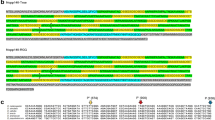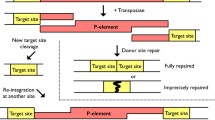Summary
A 190 by insertion is associated with the white-eosin mutation in Drosophila melanogaster. This insertion is a member of a family of transposable elements, pogo elements, which is of the same class as the P and hobo elements of D. melanogaster. Strains typically have many copies of a 190 by element, 10–15 elements 1.1–1.5 kb in size and several copies of a 2.1 kb element. The smaller elements all appear to be derived from the largest by single internal deletions so that all elements share terminal sequences. They either always insert at the dinucleotide TA and have perfect 21 bp terminal inverse repeats, or have 22 by inverse repeats and produce no duplication upon insertion. Analysis by DNA blotting of their distribution and occupancy of insertion sites in different strains suggests that they may be less mobile than P or hobo. The DNA sequence of the largest element has two long open reading frames on one strand which are joined by splicing as indicated by cDNA analysis. RNAs of this strand are made, whose sizes are similar to the major size classes of elements. A protein predicted by the DNA sequence has significant homology with a human centrosomal-associated protein, CENP-B. Homologous sequences were not detected in other Drosophila species, suggesting that this transposable element family may be restricted to D. melanogaster.
Similar content being viewed by others
References
Blackman RK, Gelbart WM (1989) The transposable element hobo of Drosophila melanogaster. In: Berg DE, Howe MM (eds) Mobile DNA. American Society for Microbiology, Washington, DC, pp 523–529
Calvi BR, Hong TJ, Findley SD, Gelbart WM (1991) Evidence for a common evolutionary origin of inverted repeat transposons in Drosophila and plants: hobo, Activator and Tam3. Cell 66:465–471
Cavener DR (1987) Comparison of the consensus sequences flanking translational start sites in Drosophila and vertebrates. Nucleic Acids Res 15:1353–1361
Charlesworth B, Langley CH (1989) The population genetics of Drosophila transposable elements. Annu Rev Genet 23:251–287
Driver A, Lacey SF, Cullingford TE, O'Hare K (1989) Structural analysis of Doe transposable elements associated with mutations at the white and suppressor of forked loci of Drosophila melanogaster. Mol Gen Genet 220:49–52
Earnshaw WC, Sullivan KF, Machlin PS, Cooke CA, Kaiser DA, Pollard TD, Rothfield NF, Cleveland DW (1987) Molecular cloning of cDNA for CENP-B, the major human centromere autoantigen. J Cell Biol 104:817–829
Engels WR (1989) P elements in Drosophila melanogaster. In: Berg DE, Howe MM (eds) Mobile DNA. American Society for Microbiology, Washington, DC, pp 437–484
Kidwell MG (1983) Evolution of hybrid dysgenesis determinants in Drosophila melanogaster. Proc Natl Acad Sci USA 80:1655–1659
Mariani C, Pirrotta V, Manet E (1985) Isolation and characterisation of the zeste locus of Drosophila. EMBO J 4:2045–2052
Masumoto H, Masukata H, Muro Y, Nozaki N, Okazaki T (1989) A human centromere antigen (CENP-B) interacts with a short specific sequence in alphoid DNA, a human centromeric satellite. J Cell Biol 109:1963–1973
Mitchelson A (1988) The suppressor of forked locus of Drosophila melanogaster. PhD thesis, University of London, London, UK
Moerman DG, Waterson RH (1989) Mobile elements in Caenorhabditis elegans and other nematodes. In: Berg DE, Howe MM (eds) Mobile DNA. American Society for Microbiology, Washington, DC, pp 537–556
Morgan TH, Bridges CB (1916) Sex-linked inheritance in Drosophila. Carnegie Inst Washington, publication No. 237
O'Hare K, Levis R, Rubin GM (1983) Transcription of the white locus in Drosophila melanogaster. Proc Natl Acad Sci USA 80:6917–6921
O'Hare K, Alley MRK, Cullingford TE, Sanderson MJ (1991) DNA sequence of the Doc retroposon in the white-one mutant of Drosophila melanogaster and of secondary insertions in the phenotypically altered derivatives white-honey and white eosin. Mol Gen Genet 225:17–24
O'Kane CJ, Gehring WJ (1988) Detection in situ of genomic regulatory elements in Drosophila melanogaster. Proc Natl Acad Sci USA 84:9123–9127
Poole SJ, Kauvar LM, Drees B, Kornberg T (1985) The engrailed locus of Drosophila: structural analysis of an embryonic transcript. Cell 40:37–43
Rio DC, Laski FA, Rubin GM (1986) Identification and immunological analysis of biologically active Drosophila P transposase. Cell 44:21–32
Sambrook J, Fritsch EF, Maniatis T (1989) Molecular cloning: A laboratory manual, 2nd edn. Cold Spring Harbor Laboratory Press, Cold Spring Harbor, New York
Wada KN, Aota SI, Tsuchiya R, Ishibashi F, Gojobori T, Ikemura T (1990) Codon usage tabulated from the GenBank genetic sequence data. Nucleic Acids Res 18:2367–2411
Woodruff RC, Blount JL, Thompson JN (1987) Hybrid dysgenesis in D. melanogaster is not a general release mechanism for DNA transpositions. Science 237:1206–1207
Author information
Authors and Affiliations
Rights and permissions
About this article
Cite this article
Tudor, M., Lobocka, M., Goodell, M. et al. The pogo transposable element family of Drosophila melanogaster . Molec. Gen. Genet. 232, 126–134 (1992). https://doi.org/10.1007/BF00299145
Issue Date:
DOI: https://doi.org/10.1007/BF00299145




